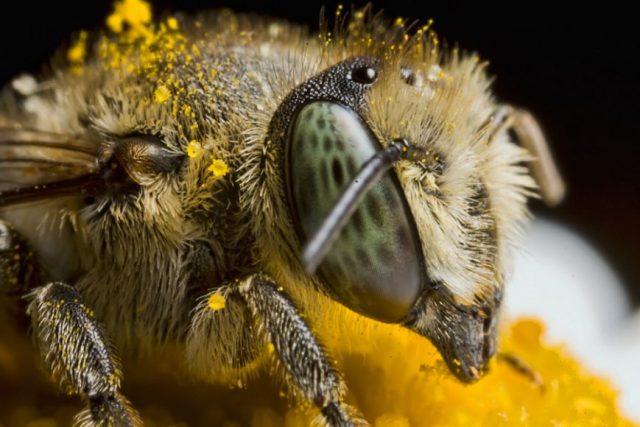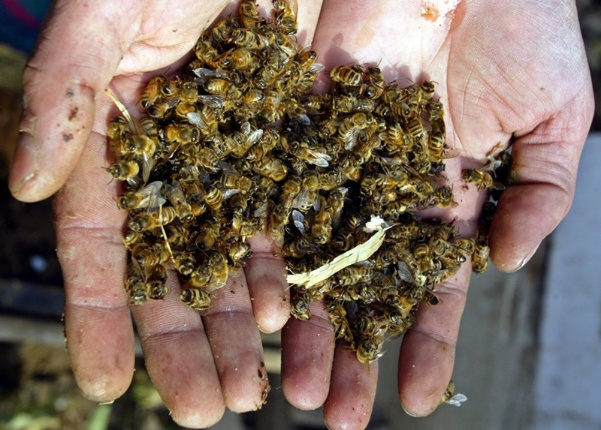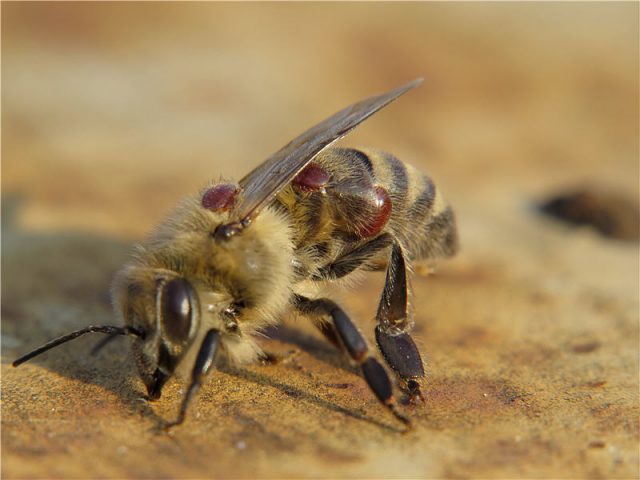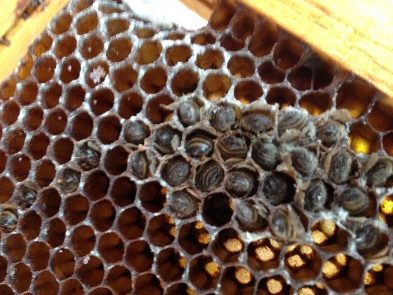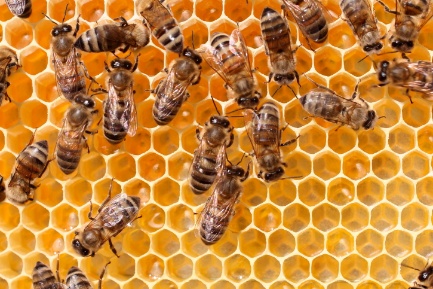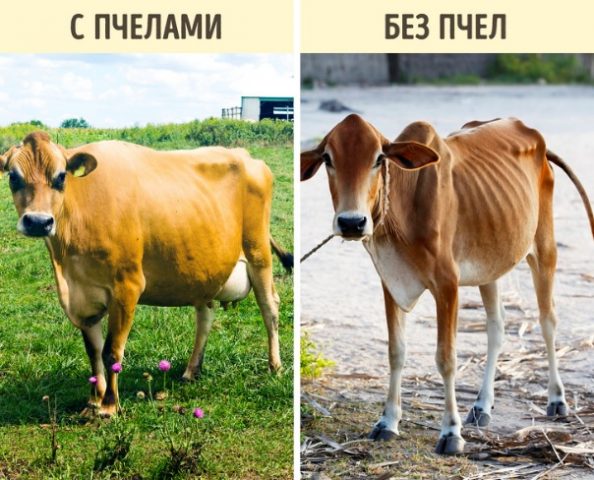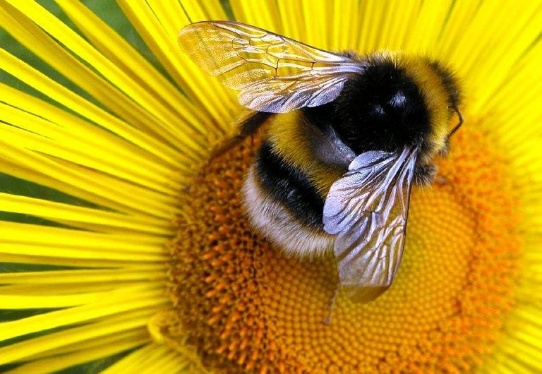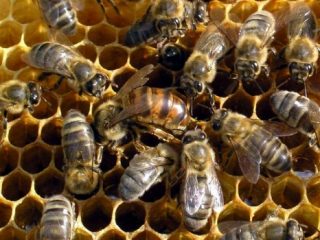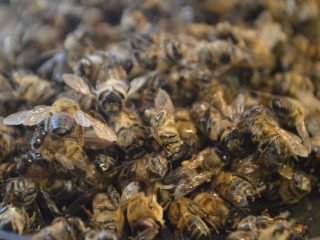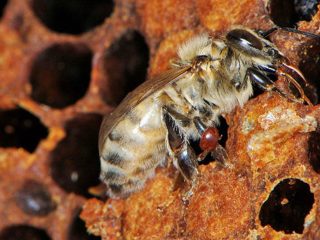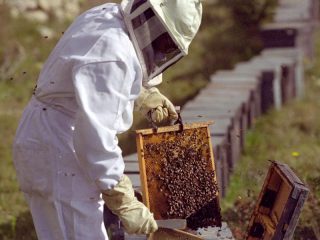Content
The phrase “bees are dying out” today sounds like an ominous harbinger of the coming apocalypse not only for humanity, but for the entire planet. But the Earth has never seen such extinctions. She will survive. And humanity will quickly disappear after the bees if it is not possible to stop the extinction of these workers.
What role do bees play?
A bee is an insect at the beginning of the food chain. This means that if the bees disappear, the whole chain will collapse. One link will disappear after another.
Bees pollinate 80% of agricultural crops. These are mainly fruit trees and shrubs. The decrease in the number of bee colonies has already led to the fact that in 2009-2013, farmers did not harvest a third of the apple and almond harvest. These crops have suffered the most from the loss of pollinators. In the United States, government support for beekeeping had to be introduced. New families are brought into the areas affected by the extinction of colonies every year.
Even self-pollinating fruits and berries without bees reduce yield.This is clearly seen in the example of strawberries, which produce 53% of the berries by self-pollination, 14% by wind, and 20% by bees. The economic damage from pollinator deaths in the United States alone already amounts to billions of dollars.
The economic damage is not as important as the fact that without pollinators, plant foods will disappear within the next year. Most cucurbits cannot produce crops by self-pollinating. The issues of survival and death of bees and humans are interconnected.
Why are bees disappearing from the planet?
The answer to this question has not yet been found. The widespread use of chemicals in fields is largely to blame for the disappearance of pollinating insects. But the version has not been conclusively proven, since there are facts that contradict this theory. There are falsifications of the results of experiments both on the part of supporters of pesticides and on the part of their opponents.
The spread of parasites and pathogens may also contribute to the decline of pollinators. Previously, bees could not fly across large expanses of water, but today they are transported by people. Along with productive insects, parasites and infections spread.
The topic of climate is also very popular. The disappearance of pollinators is attributed to cold winters. But Hymenoptera have survived not a single glaciation in their history and were not going to die out. So the reasons for the disappearance of bees on the planet are very vague. Moreover, they do not die out alone, but in the company of their relatives.
When did the bees disappear?
Pollinating insects began to disappear in the United States, and at first no one seemed to care.Just think, in California in the 70s, for unknown reasons, almost half of the bee colonies went extinct. But then extinction spread throughout the globe. And here the panic began. After all, if bees die out, the reproductive cycle of flowering plants will stop. And other pollinators will not help, since they are dying out along with honey bees.
The disappearance of Hymenoptera was noticed only in 2006, although in Great Britain alone, 23 species of bees and wasps have already become extinct since the beginning of the 20th century. And in the world the disappearance of these insects began in the 90s of the twentieth century.
In Russia the alarm was sounded in 2007. But for 10 years the problem of extinction has not been solved. In 2017, there was a record number of deaths during the wintering of colonies. In some areas, 100% of families died out, with the usual mortality rate being 10-40%.
Causes of mass death of bees
The reasons for the mass death of bees have not been established and all explanations for the extinction are still at the level of theories. Possible reasons for the extinction of bees in the world are:
- application of insecticides;
- cold winters;
- spread of pathogenic bacteria;
- spread of varroa mite;
- mass infection with microsporidia Nosema apis;
- bee colony collapse syndrome;
- electromagnetic radiation;
- the emergence of mobile communications in 4G format.
The study of the reasons for the extinction of bees is still ongoing, although the first signs of the disappearance of Hymenoptera appeared about a century ago, after the First World War. Just when it seems that the cause of pollinator deaths has already been found, data appears that contradicts the study's results.
Neonicotinoids
With the advent of relatively harmless systemic insecticides, they tried to blame them for the extinction.Studies have confirmed that bees poisoned with neonicotinoids only have half of their colonies survive the winter. But it immediately turned out that bee colonies in California began to disappear back in the 90s, when this type of pesticide was not widespread. And in Australia, the use of neonicotinoids is widespread, but bees are not going to die out. But in Australia there are no frosts or varroa mites.
Cold
In Estonia, scientists also blame pesticides for the death of apiaries, but during the cold winter of 2012-2013 and due to the late arrival of spring, 25% of families did not survive the winter. In some apiaries the death rate was 100%. It was suggested that bees weakened by insecticides were adversely affected by the cold. But Estonian beekeepers blame foulbrood for the deaths of their beekeepers.
Bacterial infection
Foulbrood or rotten is a bacterial disease that occurs in larvae. Since this is a bacterium, once the colony is damaged, it is no longer possible to get rid of the pathogen. The most common are European (Melissococcus plutonius) and American (Paenibacillus larvae) foulbrood. When infected with these bacteria, the brood dies, and then the entire colony gradually dies out.
The bacteria are sensitive to streptomycin, tetracycline antibiotics, and sulfonamides. But getting rid of the infection completely is very difficult.
Varroa
There are several types of these mites, the most dangerous of which is Varroa destructor. It is this species that is considered the main culprit of bee panzootics and the death of insects. It parasitizes Chinese wax bees and common honey bees.
It was first discovered in South Asia.As a result of trade, exchange and attempts to breed new breeds of bees, they spread throughout the world. Today, any apiary on the Eurasian continent is infected with varroa.
The female mite lays eggs in unsealed brood cells. Next, new mites parasitize the growing larvae. If only one egg was laid, the new bee will be weak and small. If two or more mites parasitize one larva, the bee will be disfigured:
- underdeveloped wings;
- small sizes;
- paws with defects.
Bees affected by Varroa at the larval stage are unable to work. With 6 mites in a cell, the larva dies. If there is a significant tick infestation, the colony dies out. The insect trade has been cited as one of the causes of extinction, as it contributes to the spread of varroa.
Nosemaapis
Microsporidia, which lives in the intestines of bees, leads to digestive disorders and often the death of the colony. The so-called “worn” honeycombs are a consequence of bee disease nosematosis. The main blame for the fact that bees began to disappear in the world is not placed on her. With a severe infection of Nosema, the bees die, remaining in the hive, but do not disappear in an unknown direction.
Bee Colony Collapse Syndrome
It is not a disease as such. One day, which is far from wonderful for him, the beekeeper discovers that bees have disappeared from the hives. All supplies and brood remain in the nest, but there are no adults. Scientists still have not figured out what makes bees leave the hive, although the number of disappearances has already grown to a percentage of the total number of colonies.
The causes of the syndrome are sought in the use of pesticides, tick infestation, or a combination of all factors. The “tick” version has certain grounds.In the wild, animals get rid of some parasites by changing shelters. A family heavily infested with ticks may, in fact, try to change their place of residence in order to get rid of some of the parasites. But since all the colonies are already infected with mites, it is also impossible to point to varroa as the only reason for the disappearance of bees. In addition to the “natural” and “chemical” reasons for the extinction of bees, there is also an “electromagnetic” theory.
Electromagnetic radiation
Another version of why bees are disappearing is the spread of mobile communications and towers for it. Since the hype around the mass death of bees began only in the 2000s, conspiracy theorists immediately linked the extinction of insects with the development of mobile communications and the increase in the number of towers. It is not clear what to do with the mass death of bees in the 70s of the last century in California and the extinction of 23 species of pollinating wasps and bees on the islands of Great Britain, which began at the beginning of the last century. After all, at that time mobile communications were only in science fiction novels. But scientists have not yet excluded this factor from being “suspected” in the death of bee colonies.
New generation mobile communication format 4G
This communication format has not even covered the entire globe yet, but it has already been made “culpable” for the death of bee colonies. The explanation is simple: the wavelength of this format coincides with the length of the bee's body. Because of this coincidence, the bee goes into resonance and dies.
The yellow press does not care about the fact that in Russia this format works only on 50% of the territory, which implies the presence of this connection only in large developed cities. An apiary in the middle of a million-plus city has nothing to do. And in remote places suitable for honey collection, there is often no mobile communication at all.
For some reason, no one is considering a couple more theories, which are also only theories for now: another mass extinction and the greed of beekeepers. The latter is especially relevant for Russia with its total passion for traditional medicine.
Mass extinction
Over the past 540 million years, the planet has experienced 25 mass extinctions. 5 of them were very large-scale. Not the biggest, but the most famous of them is the extinction of the dinosaurs. The largest extinction occurred 250 million years ago. Then 90% of all living organisms disappeared.
The most common causes of extinctions are:
- volcanic eruptions;
- climate change;
- meteor falling.
But none of these theories answer the question of why the extinction was selective. Why dinosaurs disappeared, and more ancient crocodiles and turtles remained alive, as well as what they ate and why they did not freeze. Why, as a result of the “nuclear winter” after the fall of a meteorite, dinosaurs went extinct, but bees, which arose 100 million years ago, remained alive. Indeed, according to modern theory, the death of bee colonies also occurs due to cold winters.
But if we assume that the mechanism of mass extinction of flora and fauna was triggered by some very small factor, like a worm or an insect, then everything falls into place. Those species that did not depend on this factor survived. But the “factor” did not die out because of human economic activity.
Many scientists have long come to the conclusion that humanity is living in an era of another mass extinction. If pollinating insects are the trigger for mass death today, then the Earth will face another great extinction event.And the bees disappear because they have outlived their usefulness, and the time has come to give way to new species.
Greed
Previously, only honey and wax were taken from bees. Propolis was a by-product of beekeeping. It was obtained when old hives were cleaned of bee waste products. Wax was also obtained by melting the honeycombs from which honey was extracted.
The extinction of bees, first noticed in Russia, strangely coincided with the craze for traditional medicine. Beekeeping products began to be praised as a panacea for all diseases in the world. Everything went into effect:
- honey;
- royal jelly;
- beebread;
- drone jelly.
But propolis, after its origin became widely known, was forgotten.
Of all the listed products, honey is the cheapest. Bee bread costs 4 times more than the most expensive honey, and it is difficult to resist the temptation to take it from the bees. But this is the main food of the bee colony in winter. By taking it away, the beekeeper leaves the insects hungry. And perhaps dooms them to death.
Drones are essential members of a colony. If there is a shortage of drones, the bees do not collect honey, but build drone cells and feed the drone brood. But the beekeeper selects drone combs with almost ready males and puts them under the press. This is how drone jelly/homogenate is obtained. These are unborn drones leaking out through the holes in the press. And the workers are forced to raise drone brood again instead of collecting honey and pollen.
Royal jelly is obtained by killing queen larvae. The healing properties of neither pollen nor drone and royal jelly have been officially proven.It is not surprising that with such a restless life, bees prefer to disappear into the forest and find a hollow for themselves.
This theory is confirmed by the disappearances in nature of the European aurochs (ancestor of the cow) and tarpan (ancestor of the domestic horse). But it is unlikely that these disappearances are directly related to domestication. Wild animals were food competitors for domestic animals, and humans were engaged in the extermination of “savages.” The wild ancestors of domesticated geese and ducks do not die out, but thrive. But they have never been serious competitors to domestic livestock.
The bee is not fully domesticated, but has almost disappeared in the wild. This is most likely due to sanitary logging, when hollow trees are destroyed.
Why are bees dying in Russia?
The reasons for the death of bees in Russia do not differ from those throughout the world. In other words, no one really knows anything, but they “blame” families for the extinction:
- chemicals;
- climate;
- illness;
- varroa mite.
In Russia, one can safely add the thirst for profit to the “traditional” reasons for the death of insects. Even if the beekeeper only takes honey, he usually takes more than is possible. Then the family is fed with sugar syrup so that it restores its reserves and survives the winter safely.
But back in the middle of the last century in the USSR, conscientious beekeepers strictly ensured that working individuals did not eat sugar and did not carry such “honey” into the hive. They even knew how to re-educate lazy people. Eating sugar weakens insects. At first it is imperceptible, but then “suddenly” the colony dies out.
Russian beekeepers blame neighboring farms for the extinction of bees by treating their fields with pesticides.And beekeepers have reasons for this. Russian agricultural companies often use cheap chemicals that cause the death of bees.
What happens if bees disappear
Nothing will happen:
- nor 80% of plants;
- no animals that feed on these plants;
- no people.
The disappearance of pollinating insects could be the trigger that sets off a mass extinction event. In addition to honey bees, bumblebees and wasps are becoming extinct. They all belong to the same group. Bees and bumblebees are a private version of wasps.
No one has ever wondered whether ants are dying out. If it turns out that all the “relatives” are dying out, then things are even worse than they seem. Humanity will lose all pollinators, not just bees. If bees disappear, then humanity will only have 4 years left to live. On old stocks. And only to those who manage to capture these reserves.
A plot for a horror film that can come true. The very next year, plants pollinated by bees will not produce a harvest. People will only be left with artificially bred parthenocarpic varieties of vegetables. But when self-pollinating, such varieties do not produce new seeds. And the manufacturer keeps secret how to get seeds from them.
The production of vegetables, even of such varieties, will be limited by the number of their seeds and germination period. Extinction will overtake all flowering plants on which today we could try to survive following the example of our ancient ancestors. Forage grasses that livestock eat will last for several years. But grass that does not produce seeds has a short lifespan. The grasses will begin to die out, and the livestock will follow them. Life can only remain in the sea, which has almost no connection with land and certainly does not depend on bees.
But there is not enough sea for everyone. He is no longer enough.And no one knows if it has its own “sea bee”, which is also dying out. One way or another, the familiar world will perish if bees die out. If intelligence ever appears on the planet again, scientists will also wonder about the causes of this mass extinction. And no one can tell them that the reason is the death of small, invisible insects.
What steps are being taken
Predictions regarding the complete disappearance of bees vary greatly in terms of timing. From 2035, in which bees will completely disappear, to the vague “in the next century.” Since the causes of extinction are unknown, the fight against the disappearance of bee families is carried out according to the following hypotheses:
- Europe reduces pesticide use;
- The United States is trying to create micro-robots that will replace bees in pollinating plants (you can’t count on honey);
- the Monsanto company said that solving the problem of bee extinction is on its list of priorities, but they do not believe it;
- The Russian Center for the Revival of Natural Beekeeping has developed a program to return bees to the wild.
Since the possible cause of the extinction of bees was the thoughtless import of the more productive, but heat-loving southern bee to the north, today the movement of insects has begun to be limited. Breeding of local populations is encouraged. But “pure” local subspecies of bees have almost disappeared and measures are required to restore the number of local colonies.
The subspecies of the dark forest bee has disappeared in Europe, Belarus and Ukraine. But it is still preserved in Bashkiria, Tatarstan, Perm and Altai territories, in the Kirov region. The authorities of Bashkiria banned the import of other populations into their territory so that the subspecies would no longer mix.
The program for returning bee colonies to nature provides for the preparation and creation of 50,000 apiaries of 10 families, where people will not take all the honey from the families, instead giving them sugar. The colonies will be self-sufficient. Also, bees cannot be treated with chemicals. Although it is not clear how to deal with varroa in this case. The program is designed for 16 years, during which up to 70% of swarms will be released into the wild annually.
As a result of the program, about 7.5 million bee colonies will appear in forests. They believe that this is enough for the bees to stop dying out and begin to reproduce on their own.
Bumblebee farming
In connection with the disappearance of the main worker in agriculture, a new industry began to develop: bumblebee farming. The bumblebee is more hardworking and resilient. He is less susceptible to diseases. It is not so depleted by parasites. But bumblebee farming is not being developed in Russia, and farmers buy insects abroad. Mainly in Belgium. The bumblebee is of no interest to the Russian Ministry of Agriculture. Western Europe sells bumblebees for 150-200 million euros per year.
The bumblebee has only one drawback as a pollinator: it is heavier.
Conclusion
Bees are dying out for reasons still unknown to people. With a high degree of probability, extinction is promoted by a complex of factors that alone do not kill insects. But, overlapping each other, they lead to the extinction of bee colonies.
